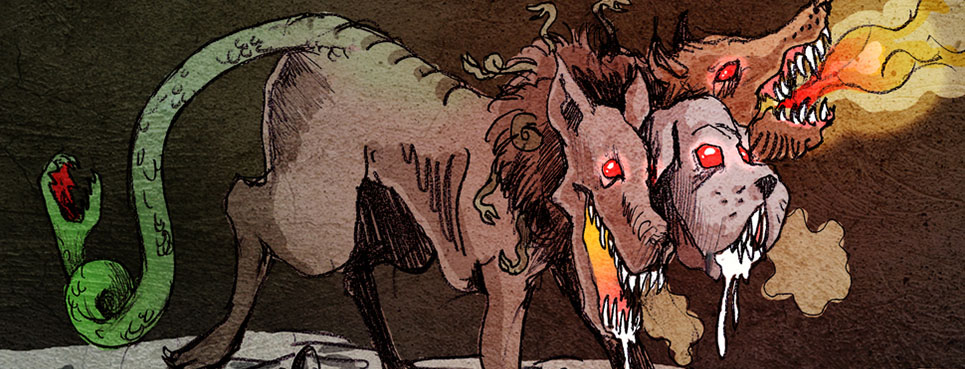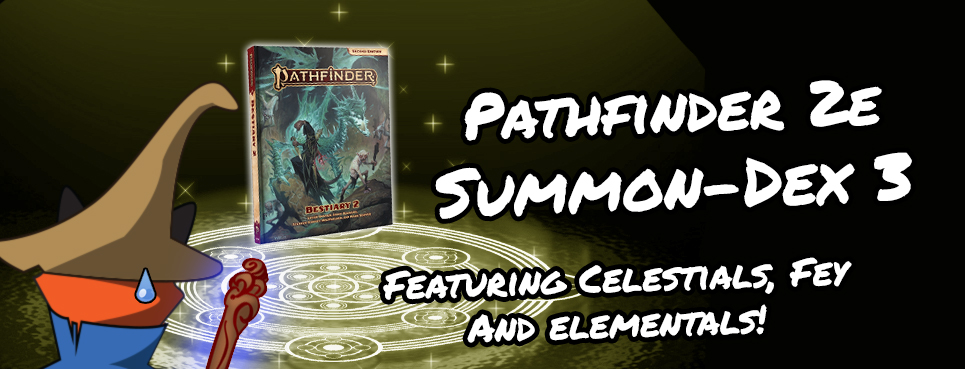Welcome to Phantasmal Killer, a blog delving into weird and fun game mechanics and how you can take advantage of them to bring new ideas to life at your tabletop. In each article I look at using a game system in unexpected ways to create unique or bizarre characters to pummel your players.
One of the most common dramatic problems for a GM in any RPG is that powerful, single villains tend to be a gamble. If they’re not significantly more powerful than the player characters, the action economy—how often each side gets to act—means your heroes can rip them to shreds before you roll their first attack. But if your villain is too powerful, they can unleash attacks that entirely overwhelm your heroes in a single blow. You might balance the action economy by giving your Big Bad Evil Guy a band of minions, but tactically-minded players know to skip the bread basket of evil and dive right into the main course. You might instead hand-waive your BBEG’s early damage rolls to give your heroes a fighting chance, but many players love the challenge of pitting their wits and luck against the gamemaster’s and resent a curated experience keeping them alive.
So how do you make your solo villain a genuine threat without getting your clock cleaned or guaranteeing a quick TPK? Let’s forget about game mechanics and look at how other media handles terrifying solo villains. In most cartoons, comics, action-oriented television shows, and films, each hero attacks and the villain gets to respond every time. The BBEG essentially gets a number of actions each round equal to the number of heroes. Those same villains generally also spend the first few exchanges shrugging off damage that would drop a hero in one shot. Is it plot armor? As the fight wears on, heroes begin to rally and push back and the villain begins to slow until one final, dramatic blow—seemingly no better than the first over-the-top attack—finally fells the fearsome foe. It’s almost as if the villain has multiple lives…
Ladies, gentlemen, and other assorted genders, allow me to introduce… The Multivillain. The Multivillain as a concept is a single villain in the fiction, but two or more enemies in the mechanics. The heroes face a single powerful opponent—Dark Emperess Xerxa, the space god Nihilon, the Iron Dragon—but as a GM you run the encounter using multiple statblocks, allowing that single enemy to act multiple times and requiring heroes to slowly weaken their opponent over time as they slowly defeat the multiple iteractions one by one, slowly turning the tide of battle in their favor. You can use five identical statblocks for your Multivillain, or mix-and-match to “break” the rules in fun ways, such as making an Unseelie Princex who is an extraordinary warrior (a high-level fighter statblock) and a deadly spellcaster (a high-level wizard), who can both battle and cast in the same round.
Your Multivillain’s actions are limited by the “party” making up its collection of statblocks. This is simple enough if they’re made up of four copies of the same statblock—just roll initiative four times and take an action each time—but more complicated if you mix and match. The aforementioned Unseeling Princex, being made from a fighter and a wizard, would roll initiative twice and be able to take a full round of fighter actions on one initiative and a full round of wizard actions on the other initiative—but they couldn’t cast two rounds’ worth of wizard spells.
You can track the Multivillain’s health across its various statblocks, switching which takes damage based on which statblock acted most recently. You can simplify the math by instead tracking the Multivillain’s health as a single total, eliminating statblocks as its accumulated damage reaches regular thresholds. If your Multivillain consists of three barbarians, for example, just add the three hit point totals together into a single pool, then reduce her number of turns by one when the pool is reduced to two-thirds, and again when its reduced to one-third of the total hit points.
When using a Multivillain, pay careful attention to your system’s rules for scaling challenges. Your first instinct is to scale a BBEG far beyond the level of your heroes, but always remember that your heroes are effectively facing a gang of opponents, not just one. In most cases, your Multivillain’s individual components should be about as powerful as a single PC, or only slightly more powerful. Your exact game system can help you figure out the right balance.
Cerberus – Mutants & Masterminds
Cerberus, the three-headed guardian of the underworld from Greek myth, is a perfect example of a Multivillain; he’s literally three opponents sharing a single body! Using Mutants & Masterminds, 3rd Edition, you can build a textbook-legal three-headed servant of Hades as a single statblock to represent the body and central head. We’ll call the central statblock Ber (in mythology, the three heads don’t have separate names, so I’m choosing to label them Cer, Ber, and Us). Giving Ber 50 ranks in the Sidekick advantage grants him two 125-point lieutenants loyal to him. We can give Cer and Us very similar, slightly less powerful statblocks, but also the Interpose advantage, allowing them to take any nasty hits intended for Ber and meaning heroes must take out the two subordinate heads before they can begin the affect the “core” monster. Making Ber slightly more powerful means that although the fight gets easier as they take push the attack, last piece of the Multivillain left standing is still a respectable threat on its own.
Giving Cerberus the Sidekick and Interpose advantages are mostly just mechanical ways of illustrating the Multivillain at the table: Cerberus is a single monster, and all three of its heads—its separate statblocks—move with the body as a single being. He’s a single opponent who gets to act three times in a round and must effectively be defeated three times for the heroes to finally triumph! You don’t need to use these Advantages in your own Mutants & Masterminds Multivillains, or in Multivillains you create in any other system.
Cerberus PL 12
STR 11, STA 14, AGL 3, DEX –1, FGT 9, INT 0, AWE 5, PRE 4
Powers: Ghost Fang Strength-Based Damage 2 (Affects Insubstantial 2), Creepy Canine Senses Senses 9 (Accurate Acute Smell, Sight Counters Concealment: Spirits, Darkvision, Tracking, Ultra-hearing), Titanic Growth 8 (Innate; Permanent).
Advantages: Animal Empathy, Daze (Intimidation), Diehard, Fascinate (Intimidation), Fearless, Improved Disarm, Improved Grab, Improved Hold, Seize Initiative, Set-up 2, Sidekick 50 (2 125-point sidekicks), Startle, Takedown, Teamwork, Uncanny Dodge.
Skills: Expertise: Spirit Law 6 (+6), Insight 3 (+8), Intimidation 4 (+12), Perception 3 (+8), Stealth 10 (+5).
Offense: Init +3, Bite +9 (Close, Damage 13).
Defense: Dodge 8, Parry 10, Fortitude 14, Toughness 14, Will 8.
Totals: Abilities 58 + Powers 30 + Advantages 65 + Skills 13 (26 ranks) + Defenses 17 = 183
Cer and Us PL 10
STR 10, STA 12, AGL 3, DEX –1, FGT 8, INT 0, AWE 5, PRE 4
Powers: Ghost Fang Strength-Based Damage 2 (Affects Insubstantial 2), Creepy Canine Senses Senses 9 (Accurate Acute Smell, Sight Counters Concealment: Spirits, Darkvision, Tracking, Ultra-hearing), Titanic Growth 8 (Innate; Permanent), Watch the Future/Past Senses 4 (Precognition [Cer]/Postcognition [Us]).
Advantages: Animal Empathy, Daze (Intimidation), Diehard, Fascinate (Intimidation), Fearless, Improved Disarm, Improved Grab, Improved Hold, Interpose, Seize Initiative, Set-up 2, Startle, Takedown, Teamwork.
Skills: Expertise: Spirit Law 6 (+6), Insight 3 (+8), Intimidation 4 (+12), Perception 3 (+8), Stealth 10 (+5).
Offense: Init +3, Bite +8 (Close, Damage 12).
Defense: Dodge 6, Parry 8, Fortitude 12, Toughness 12, Will 7.
Totals: Abilities 50 + Powers 34 + Advantages 15 + Skills 13 (26 ranks) + Defenses 13 = 125







